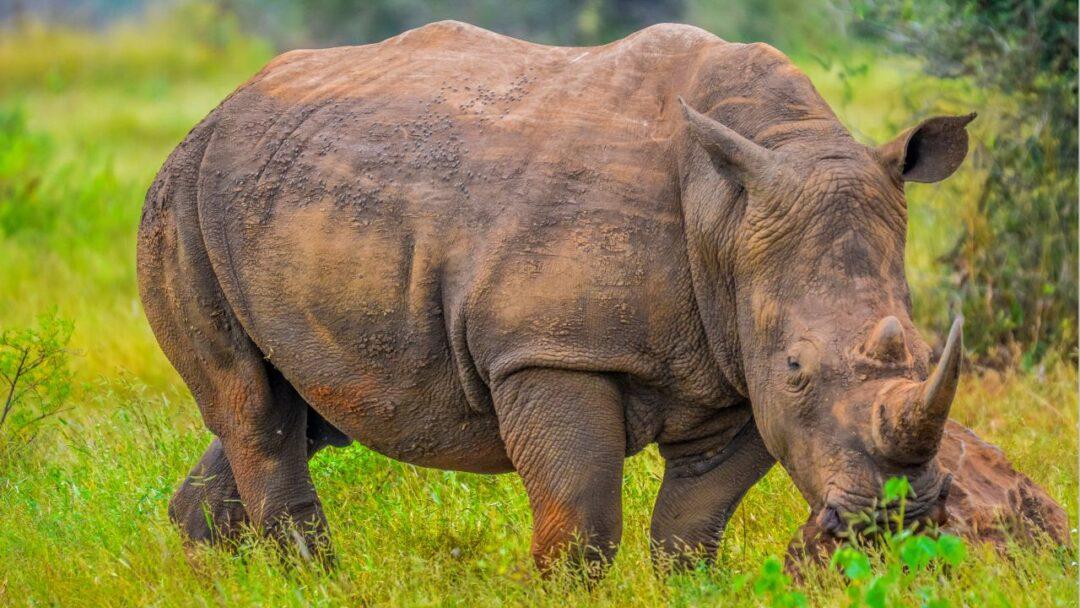Table of Contents

Introduction
Rhinoceroses are magnificent animals that have sparked people’s curiosity all around the world. The prominent horns, enormous stature, and distinctive features of these gentle giants are well known. In this post, we’ll look at ten fascinating rhinoceros facts, including some enigmatic information, urban legends, and the animals’ ecological significance.
10 Interesting Facts About Rhinoceroses
- Rhinoceroses are not just one species, there are five: Rhinoceroses come in five different species – the White Rhinoceros, Black Rhinoceros, Indian Rhinoceros, Javan Rhinoceros, and Sumatran Rhinoceros.
- Rhinoceros horns are not made of bone, but of keratin: Rhino horns are made of keratin, which is the same material that makes up human hair and nails.
- Rhinoceroses have poor eyesight but excellent hearing and sense of smell: Rhinoceroses have poor eyesight, but they make up for it with their excellent sense of hearing and sense of smell.
- Rhinoceroses can weigh up to 2,000 kilograms: Rhinoceroses are massive creatures that can weigh up to 2,000 kilograms.
- Rhinoceroses are herbivores: Rhinoceroses feed on a variety of plants, including grasses, leaves, and fruits.
- Rhinoceroses are solitary animals: Rhinoceroses are generally solitary animals, except during mating season and when a female is raising her young.
- Rhinoceroses can run up to 55 km/h: Despite their size, rhinoceroses can run up to 55 km/h.
- Rhinoceroses are critically endangered: All five species of rhinoceroses are currently classified as critically endangered due to habitat loss and poaching.
- Rhinoceroses are very territorial: Rhinoceroses are very territorial and will defend their territory aggressively against other animals.
- Rhinoceroses have a prehistoric ancestry: Rhinoceroses have been around for millions of years and their ancestors date back to prehistoric times.
Mysterious Facts and Myths
Rhinoceroses have long been associated with myths and mysteries. Here are some interesting facts and myths about rhinoceroses:
- In some cultures, rhinoceros horns are believed to have medicinal properties and are used in traditional medicine.
- It is believed that rhinoceroses are able to communicate with each other through infrasonic sounds that humans cannot hear.
- It is a myth that rhinoceroses have poor memories. In fact, they have been known to remember individuals and events for many years.
Important to Ecosystem
In the ecosystem, rhinoceroses are crucial. They are herbivores, and by grazing, they assist in regulating plant development. In addition to being a source of food for predators, rhinoceroses can alter the environment due to their size and strength.
What are rhinoceroses?
Rhinoceroses, also known as rhinos, are huge herbivorous animals in the Rhinocerotidae family. They are distinguished by their prominent horns and sturdy frame.
How many species of rhinoceroses are there?
The rhinoceros is divided into five species: white rhinoceros, black rhinoceros, Indian rhinoceros, Javan rhinoceros, and Sumatran rhinoceros.
What is the difference between white and black rhinoceroses?
The primary distinction between white and black rhinoceroses is based on physical traits and feeding patterns. The terms “white” and “black” are essentially mistranslations. For feeding on grass, white rhinos have a large, square-shaped mouth, but black rhinos have a prehensile upper lip for browsing on leaves and twigs.
Are rhinoceroses endangered?
Unfortunately, all rhinocerose species are endangered. Poaching for their horns, habitat loss, and illicit wildlife trading pose severe dangers to them.
Why are rhinoceros horns valuable?
In some traditional Asian medicine systems, rhinoceros horns are incorrectly believed to have medicinal virtues, resulting in a great demand for them. They are also highly for as status symbols and for ornamental uses.
How long can rhinoceros horns grow?
The length of rhino horns varies depending on the species. The longest rhino horn ever measured around 1.58 meters (5.18 ft).
Can rhinoceroses charge and attack humans?
Rhinoceroses are normally gentle animals, but if threatened or disturbed, they can turn hostile. When encountering them in the wild, it is critical to keep a safe distance and respect their space.
What is being done to protect rhinoceros populations?
Anti-poaching tactics, habitat preservation, public awareness initiatives, and international cooperation are all part of conservation efforts to protect rhinoceros populations. Breeding initiatives, as well as stringent enforcement of the law against illegal wildlife trading, are also critical for their conservation.
How can I support rhinoceros conservation?
You may help rhinoceros conservation by donating to trustworthy organizations committed to their protection, creating awareness about the necessity of conservation, and refraining from purchasing or supporting rhino horn products.
Can rhinoceroses be found in zoos?
Yes, rhinoceroses are housed in many zoos throughout the world as part of conservation and education programs. Zoos serve an important role in raising awareness about these endangered species and doing research to help them survive.
Conclusion
Rhinoceroses are fascinating animals with a distinctive set of traits. They are enormous, herbivorous, and prehistoric in origin. Due to habitat degradation and poaching, rhinoceroses are highly endangered, and preserving them is essential to preserving the ecosystem’s equilibrium.
10 Fascinating Facts About Ferrets : NEXT POST



